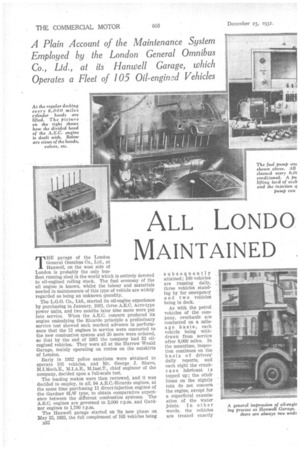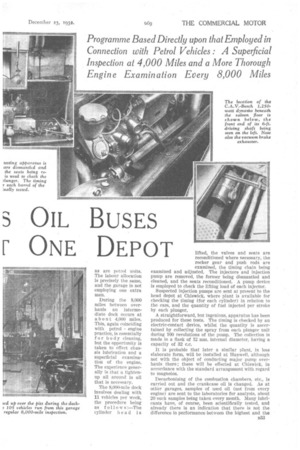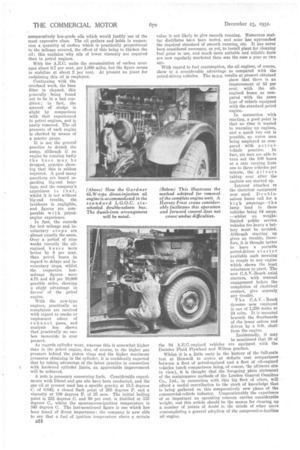T HE garage of the London General Omnibus Co., Ltd., at
Page 42

Page 43

Page 44

If you've noticed an error in this article please click here to report it so we can fix it.
Hanwell, on the west side of London is probably the only busfleet running shed in the world which is entirely devoted to oil-engined rolling stock. The fuel economy of the oil engine is known, whilst the labour and materials needed in maintenance of this type of vehicle are widely regarded as being an unknown quantity.
The L.G.O. Co.' Ltd., started its oil-engine experience by purchasing in January, 1931, three A.E.C. Acro-type power units, and two months later nine more were put into service. When the A.E.C. concern produced its engine embodying the Ricardo principle a preliminary service test showed such marked advance in performance that the 12 engines in service were converted to the new combustion system and 20 more were ordered, so that by the end of 1931 the company had 32 oilengined vehicles. They were all at the Harrow Weald Garage, mainly operating on routes on the outskirts of London.
Early in 1932 police sanctions were obtained to operate 105 vehicles, and Mr. George J. Shave, M.1.Mech.E., M.I.A.E., M.Inst.T., chief engineer of the company, decided upon a full-scale test.
The leading makes were then reviewed, and it was decided to employ, in all, 94 A.E.C.-Ricardo engines, at the same time purchasing 11 direct-injection engines of the Gardner 6LW type, to obtain comparative experience between the different combustion systems. The A.E.C. engines are governed to 2,000 r.p.m. and Gardner engines to 1,700 r.p.m.
The Hanwell garage started on its new phase on May 25, 1932, the full complement of 105 vehicles being subsequently attained ; 100 vehicles are running daily, three vehicles standing by for emergency and two vehicles being in dock.
As with the petrol vehicles of the company, overhauls are conducted on a mileage basis, each vehicle being withdrawn from service after 8,000 miles. In the meantime, inspection continues on the b as is of drivers' daily reports; and each night the crankcase lubricant is topped up ; the other items on the nightly rota do not concern the engine, except for a superficial examination of the water joints. In other words, the vehicles are treated exactly as are petrol units. The labour allocation is precisely the same, and the garage is not employing one extra man.
During the 8,000 miles between overhauls an intermediate dock occurs at about 4,000 miles. This, again coinciding with petrol engine practice, is essentially for body cleaning, but the opportunity is taken to effect chassis lubrication and a superficial examination of the engine. The experience generally is that a tightenup all around is all that is necessary.
The 8,000-mile dock Involves dealing with 11 vehicles per week, the procedure being as f o 11 o w s :—The cylinder head is lifted, the valves and seats are reconditioned where necessary, the rocker gear and push rods are examined, the timing chain being examined and adjusted. The injectors and injection pump are removed, the former being dismantled and cleaned, and the seats recOnditioned. A pump device is employed to check the lifting load of each injector.
Suspected injection pumps are sent at present to the head depot at Chiswick, where plant is available for checking the timing (for each cylinder) in relation to the cam, and the quantity of fuel injected per stroke by each plunger.
A straightforward, but ingenious, apparatus has been produced for these tests. The timing is checked by an electric-contact device, whilst the quantity is ascertained by collecting the spray from each plunger unit during 100 revolutions of the pump. The collection is made in a flask of 12 tom, internal diameter, having acapacity of 32 c.c.
It is probable that later a similar plant, in less elaborate form, will be installed at 'Unwell, although not with the object of conducting major pump overhauls there; these will be effected at Chiswick, in accordance with the standard arrangement with regard to magnetos.
Decarbonizing of the combustion chambers, etc., is carried out and the crankcase oil is changed. As at other garages, samples of used oil (not from every engine) are sent to the laboratories for analysis, about 20 such samples being taken every month. Many lubricants have, of course, been scientifically tested, and already there is an indication that there is not the difference in performance between the highest and the
comparatively low-grade oils which would justify use of the most expensive class. The ail gathers and holds in suspension a quantity of carbon which is practically proportional to the mileage covered, the effect of this being to thicken the oil ; this explains why oils of lower viscosity are required than in petrol engines.
With the A.E.C. units the accumulation of carbon averages about 0.7 per cent. per 1,000 miles, but the figure seems to stabilize at about 2 per cent. At present no plant for reclaiming this oil is employed.
Continuing with the overhaul work, the base filter is cleaned, this generally beins' found not to he in a bad condition; in fact, the amount of sludge is slight by comparison with that experienced in petrol engines' and is easily removed. The oil pressure of each engine Is checked by means of a master gauge.
It is not the general practice to detach the sump, although if an
s be running badly the base may be
• dropped, practice showing that this is seldom required. A good many questions are heard regarding big-end bearings, and the company's experience is that, whilst it is not without big-end trouble, the incidence is negligible, and figures are comparable sv i t h petrolengine experience.
. In fact, the records for lost mileage and involuntary stops are almost exactly the same. Over a period of nine weeks recently the oilengined buses Were better by 8 per cent. than petrol buses in regard to delays and involuntary stops, whilst the respective lostmileage figures were 4.75 and 4.6 per 10,000 possible miles, showing a slight advantage in favour' of the petrol engine.
With the new-type engines, practically no complaints are received with regard to smoke or unpleasant odour of exhaust gases, and analysis has shown that practically no earbon monoxide is ever present.
As regards cylinder wear, whereas this is somewhat higher than in the petrol engine, due, of course, to the higher gas pressure behind the piston rings and the higher maximum pressures obtaining in the cylinder, it is confidently expected that by taking advantage of the latest practice in connection with hardened cylinder liners, an appreciable ithprovement will he achieved.
A note is necessary concerning fuels. Considerable experiments with Diesel and gas oils have been conducted, and the gas oil at present used has a specific gravity at 15.5 degrees C. of 0.842, a closed flash point of 205 degrees F. and a viscosity at 100 degrees F. of 35 secs. The initial boiling point is 223 degrees C. and 90 per cent, is distilled at 335 degrees C., whilst the spontaneous-ignition temperature is 345 degrees C. The last-mentioned ggure is one which has been found of direct importance; the company is now able to say that a fuel of ignition temperature above a certain (Above) How the Gardner 6LW-type direct-injection oil engine is accommodated in the standard L.G.O.C. sixwheeled double-saloon bus. The dumb-iron arrangement will be noted.
value is not likely to give smooth running. Numerous coaltar distillates have been tested, and none has approached the required standard of smooth running, etc. It has never been considered necessary, as yet, to install plant for cleaning fuel prior to use, and much more suitable and reliable fuels are now regularly marketed than was the case a year or two ago.
With regard to fuel consumption, the oil engines, of course, show to a considerable advantage as compared with the petrol-driven vehicles. The m.p.g. results at present obtained show that there is an improvement of 82 per cent, with the oilengined buses as compared with the same type of vehicle equipped with the standard petrol engine.
In connection with starting, a good point is that no time is wasted in warming up engines, and a quick run out is possible, no extra men being employed as compared with pets olvehicle practice. In fact, six men are able to turn out the 100 buses at a rate varying from one to three vehicles per minute, the drivers taking over after the engines are started up.
Interest attaches to the electrical equipment now used. Doubt esaloon buses call for a high amperage—the lamp load in these vehicles being 54 amps. —vslailst on weightlimited public service vehicles too heavy a battery must be avoided. Although starting up gives no trouble, therefore, it is thought better to have a portable petrol-driven st art er available each morning to couple to any engine which shows the least reluctance to start. The new C.A.V.-Bosch axial starters, with manual engagement before the completion of electrical contact, give scarcely any trouble.
The C.A.V. Bosch dynamo now employed is one of 1,250 watts at 24 volts. It is mounted beneath the floorboards of the lower saloon and driven by a 6-ft. shaft from the engine.
Incidentally, it may be mentioned that 20 of the 94 A.E.Osengined vehicles are equipped with the Daimler Fluid Flywheel and Wilson gearbox.
Whilst it is a little early in the history of the full-scale test at Hanwell to arrive at definite cost comparisons between a fleet of petrol-engined and a fleet of oil-engined vehicles (such comparisons being, of course, the ultimate aim in view), it is thought that the foregoing plain statement of the maintenance methods of the London General Omnibus Co., Ltd., in connection with this big fleet of oilers, will afford a useful contribution to the stock of knowledge that is being gathered on this comparatively new phase of the commercial-vehicle industry. Unquestionably the experience of so important an operating' concern carries considerable weight, and this article should be the means for clearing. up a number of points a doubt in the minds of other users contemplating a general adoption of the compression-ignition oil engine.




















































































